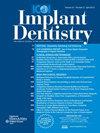Chemical Stability and Antimicrobial Activity of Plasma-Sprayed Cerium Oxide-Incorporated Calcium Silicate Coating in Dental Implants.
3区 医学
Q1 Dentistry
引用次数: 12
Abstract
PURPOSE The aim of this study is to investigate the biological activity and antibacterial property of cerium oxide-incorporated calcium silicate coatings (CeO2-CS) in dental implants. MATERIALS AND METHODS In this study, MC3T3-E1 cells cultured on the plastic, Ti-6Al-4V, and the cerium oxide-incorporated calcium silicate coatings (CeO2-CS) coating served as the blank, control, and CeO2-CS groups, respectively. A cell counting kit-8 (CCK-8) and flow cytometry were used to evaluate the biocompatibility. The osteoblastic differentiation of the MC3T3-E1 cells was also analyzed by quantitative real-time polymerase chain reaction analysis. The CCK-8 and counts of colony-forming units (CFUs) were used to detect the antibacterial activity of the coating on Enterococcus faecalis. The study showed that the cerium oxide-incorporated calcium silicate coating (CeO2-CS) has better biocompatibility. Meanwhile, the ALP, OCN, and BSP mRNA expression levels in the CeO2-CS group were significantly upregulated (P < 0.05). The number of viable bacteria and the CFU results were significantly reduced in the CeO2-CS group (P < 0.05). CONCLUSION The cerium oxide-incorporated calcium silicate coatings (CeO2-CS) may promote the osteoblastic differentiation of osteoblasts. Meanwhile, the cerium oxide-incorporated calcium silicate coating (CeO2-CS) showed strong antimicrobial activity on E. faecalis, with good biocompatibility.牙科植入物中等离子喷涂氧化铈结合硅酸钙涂层的化学稳定性和抗菌活性。
目的本研究的目的是研究掺入氧化铈的硅酸钙涂层(CeO2-CS)在种植牙中的生物活性和抗菌性能。材料和方法在本研究中,在塑料、Ti-6Al-4V和掺有氧化铈的硅酸钙涂层(CeO2-CS)上培养的MC3T3-E1细胞分别作为空白组、对照组和CeO2-CS组。采用细胞计数试剂盒-8(CCK-8)和流式细胞仪对其生物相容性进行评价。MC3T3-E1细胞的成骨细胞分化也通过定量实时聚合酶链反应分析进行分析。使用CCK-8和菌落形成单位计数(CFU)来检测涂层对粪肠球菌的抗菌活性。研究表明,掺入氧化铈的硅酸钙涂层具有较好的生物相容性。同时,CeO2-CS组ALP、OCN和BSP mRNA表达水平显著上调(P<0.05),活菌数和CFU结果显著降低(P<0.05)。同时,掺入氧化铈的硅酸钙涂层(CeO2-CS)对粪肠球菌具有较强的抗菌活性,具有良好的生物相容性。
本文章由计算机程序翻译,如有差异,请以英文原文为准。
求助全文
约1分钟内获得全文
求助全文
来源期刊

Implant Dentistry
医学-牙科与口腔外科
CiteScore
4.00
自引率
0.00%
发文量
0
审稿时长
6-12 weeks
期刊介绍:
Cessation. Implant Dentistry, an interdisciplinary forum for general practitioners, specialists, educators, and researchers, publishes relevant clinical, educational, and research articles that document current concepts of oral implantology in sections on biomaterials, clinical reports, oral and maxillofacial surgery, oral pathology, periodontics, prosthodontics, and research. The journal includes guest editorials, letters to the editor, book reviews, abstracts of current literature, and news of sponsoring societies.
 求助内容:
求助内容: 应助结果提醒方式:
应助结果提醒方式:


